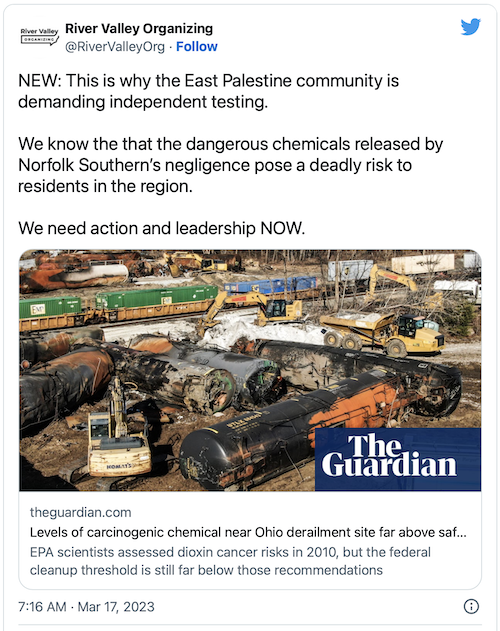“I certainly wouldn’t be comfortable living there,” said one organic chemist.

Ohio EPA and EPA contractors collect soil and air samples from the Norfolk Southern train derailment site on March 9, 2023 in East Palestine, Ohio. (Photo: Michael Swensen/Getty Images)
East Palestine, Ohio residents’ concerns about the enduring impact of last month’s fiery train derailment are likely to intensify following the release of data showing that levels of dioxin in the soil near the wreck site are far higher than the cancer risk threshold recommended by federal scientists.
Dioxin is a toxic and carcinogenic byproduct of burning vinyl chloride, a hazardous chemical that at least five Norfolk Southern train cars were carrying when they derailed in early February, sparking a full-blown environmental and public health disaster.
Citing a report that Pace Analytical prepared for Ohio’s neighbor Indiana, The Guardian reported Friday that “East Palestine soil showed levels of ‘2,3,7,8 TCDD toxicity equivalence’ of 700 parts per trillion (ppt),” potentially stemming from the controlled burn of vinyl chloride in the wake of the crash.
“The level at which the EPA will initiate cleanup action in residential areas is 1,000 ppt,” the newspaper explained. “However, the cleanup triggers are much lower in many states – 90 ppt in Michigan, and 50 ppt in California… Moreover, EPA scientists in 2010 put the cancer risk threshold for dioxins in residential soil at 3.7 ppt, and the agency recommended lowering the cleanup trigger to 72 ppt.”
The Obama administration tanked the EPA scientists’ effort to formally lower the federal cleanup threshold, The Guardian noted.
Chemical experts and former EPA officials expressed alarm over the data while acknowledging it was limited to just two soil samples and more testing is needed.
“The levels are not screaming high, but we have confirmed that dioxins are in East Palestine’s soil,” Linda Birnbaum, former head of the U.S. National Toxicology Program, told The Guardian. “The EPA must test the soil in the area more broadly.”
Carsten Prasse, an organic chemist at Johns Hopkins University, added that the dioxin concentrations in the soil samples examined are “actually concerning.”
“My main concern is: is this reflective of the level in the area in East Palestine… and of the levels individuals who live near the rail are exposed to?” Prasse asked. “I certainly wouldn’t be comfortable living there.”
Despite outside experts’ fears, EPA regional administrator Debra Shore insisted that the dioxin levels detected in the Indiana report are “very low.”
 The Guardian‘s reporting came days after Ohio’s Republican attorney general filed suit against Norfolk Southern, accusing the rail giant of “recklessly endangering” East Palestine residents.
The Guardian‘s reporting came days after Ohio’s Republican attorney general filed suit against Norfolk Southern, accusing the rail giant of “recklessly endangering” East Palestine residents.
“Ohio shouldn’t have to bear the tremendous financial burden of Norfolk Southern’s glaring negligence,” said AG Dave Yost said. “The fallout from this highly preventable incident may continue for years to come, and there’s still so much we don’t know about the long-term effects on our air, water, and soil.”
 In Congress, a bipartisan group of lawmakers is working to build support for legislation that would impose more strict regulations on trains carrying hazardous materials such as vinyl chloride.
In Congress, a bipartisan group of lawmakers is working to build support for legislation that would impose more strict regulations on trains carrying hazardous materials such as vinyl chloride.
During Senate testimony last week, Norfolk Southern CEO Alan Shaw refused to endorse the bill.
“If Norfolk Southern had paid a little more attention to safety and a little less attention to its profits – had cared a little more about the Ohioans along its tracks, and a little less about its executives and shareholders – these accidents would not have been as bad, or might not have happened at all,” Sen. Sherrod Brown (D-Ohio), the lead Democratic sponsor of the Railway Safety Act, said during the hearing.
Written by Jake Johnson for Common Dreams ~ March 17, 2023
